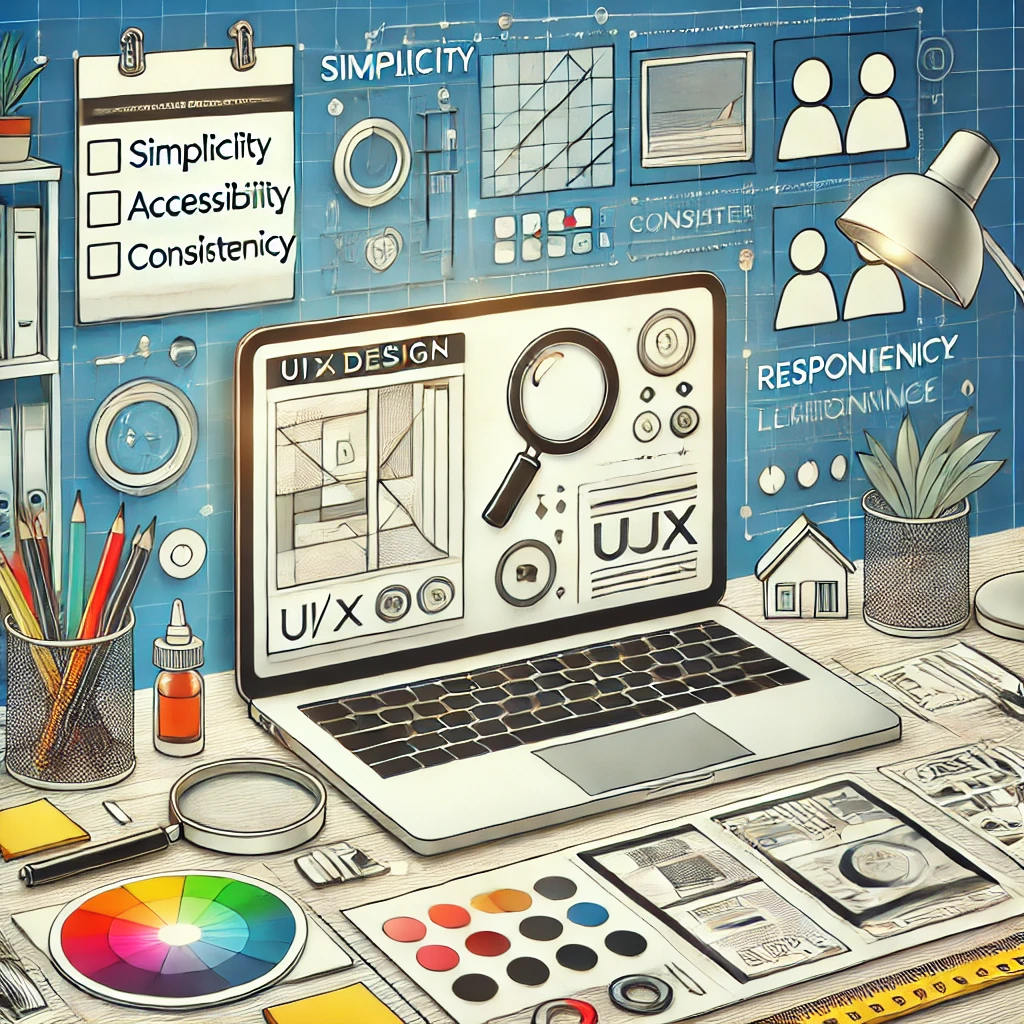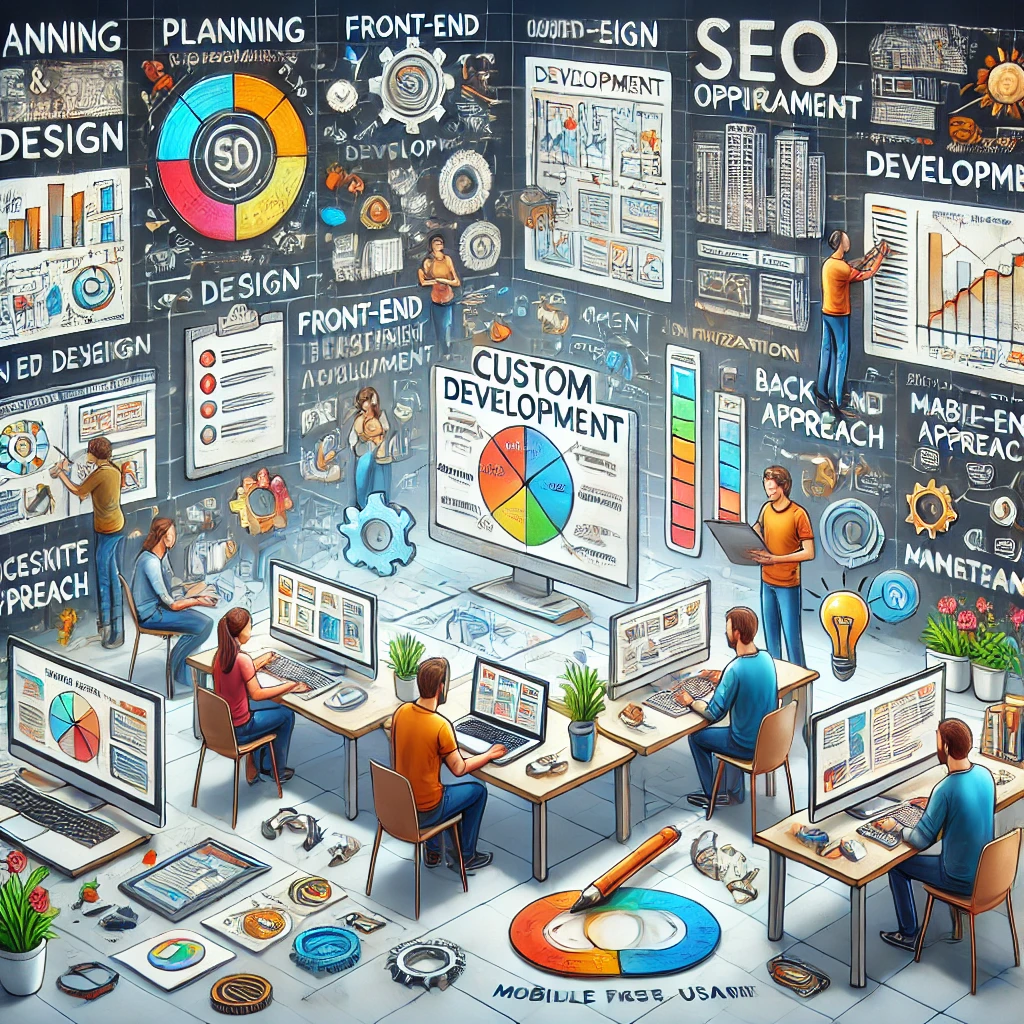PUBLISHED ON: December 16, 2024

Let's Talk
User experience UX is the overall feeling a user has when interacting with a product or service. It’s about creating easy, efficient, and enjoyable interactions. This article will cover essential tips and principles to help you master UX design for better user satisfaction and business success.
Key Takeaways
• User experience (UX) design is centered around understanding user needs and preferences to create intuitive, engaging, and accessible interfaces that enhance satisfaction and loyalty. • Key principles of UX design include usability, design clarity, consistency, empathy, and inclusivity, which collectively improve navigation and increase user engagement. • Incorporating user research and feedback throughout the design process is essential for creating effective UX, as it allows designers to iteratively refine products based on user insights and real-world usability testing.Understanding User Experience (UX)
User experience (UX) encompasses every aspect of an end-user’s interaction with a company, its services, and its products. It’s about creating a smooth and enjoyable journey for users, from their first encounter to their last. Whether it’s a website, an app, or a physical product, UX design aims to enhance the overall user journey by addressing their needs and preferences. Understanding user needs and preferences is the cornerstone of effective UX design. It’s not just about creating visually appealing interfaces; it’s about ensuring that the design resonates with the audience. Focusing on user needs allows designers to create user-centric designs that boost satisfaction and loyalty. This, in turn, translates into better business outcomes, as satisfied users are more likely to engage, convert, and remain loyal. A strong user experience can significantly enhance trust, reduce bounce rates, and increase conversion rates. When users find an interface easy to navigate and interact with, they are more likely to stay longer and return in the future. Key elements of effective UX design include creating user-friendly interfaces, ensuring clear navigation, maintaining consistency across platforms, and being responsive to user needs. In essence, UX design is about creating a seamless and intuitive experience that makes users feel valued and understood. By prioritizing user satisfaction and trust, businesses can build stronger relationships with their audience and achieve sustained success.Key Principles of UX Design
Usability is a fundamental principle of UX design, referring to how easily users can interact with and learn to use a website or application. It’s about creating interfaces that are intuitive and efficient, allowing users to achieve their goals with minimal effort. Adhering to usability principles, such as clear navigation and easy-to-understand content, can significantly enhance user experience and engagement. Designing for clarity is another essential principle. Providing well-organized information and straightforward content improves usability and reduces user frustration. User-centered design goes a step further by prioritizing the needs, behaviors, and preferences of users. This approach ensures that the design resonates with the audience and addresses their pain points effectively. Consistency in design is crucial for creating a seamless user experience. When users encounter familiar design elements across different platforms, their learning curve is reduced, and they can navigate more comfortably. Empathy is also vital in UX design. Considering the experiences of diverse users and integrating their feedback early in the design process leads to more inclusive and user-friendly interfaces. Accessibility is another key principle, emphasizing the importance of designing for all users, regardless of their abilities or backgrounds. Inclusive practices, such as addressing language and cultural differences, ensure that a wide range of users can interact comfortably with the interface. Adhering to these principles allows UX designers to create intuitive, engaging, and effective digital experiences.The Role of User Research in UX Design
User research is the backbone of effective UX design. It involves gathering insights into users’ challenges, needs, and behaviors, which informs the design process and ensures that the final product aligns with user expectations. Conducting thorough user research enables designers to make informed decisions and significantly enhance the design process. Successful user experiences are often the result of extensive user research. This research helps designers understand what users want and need, allowing them to create products that meet those expectations. Engaging in user research also cultivates empathy, enabling designers to better understand and address user needs. This empathy is critical for creating designs that resonate with users on a deeper level. User research can also save time and resources by preventing the development of features that do not effectively solve user problems. Understanding user behavior and preferences helps designers create more intuitive navigation and interaction designs. In this way, user research not only improves the design but also ensures that resources are used efficiently and effectively. Incorporating user research into the design process is not just a best practice—it’s essential for creating successful user experiences. Continuously gathering and analyzing user insights helps designers iterate and refine their designs to better meet user needs and expectations.Usability Testing: Methods & Importance
Usability testing is a crucial step in the UX design process. Its primary aim is to gather data to identify usability problems and enhance the design of a website or application. Conducting usability tests allows designers to pinpoint pain points and improve navigation and interaction, ultimately enhancing the overall user experience. There are various methods of usability testing, each offering unique insights. Card sorting, for instance, helps organize website content by allowing users to categorize items and label them, clarifying navigation structure. Observational methods provide direct insights into user behavior and how they interact with the design. Both qualitative and quantitative metrics are used in usability testing to measure users’ effectiveness, productivity, and satisfaction in achieving their goals. Usability testing can be conducted in-person or remotely. In-person testing allows observers to engage with users directly, asking questions as they complete tasks. Remote usability testing, on the other hand, enables users to complete tasks in their own environments, often recorded through webcams. Both methods offer valuable insights and can be used to identify and address usability issues before costly mistakes occur. Continuously gathering and analyzing usability feedback helps designers solve issues and enhance the overall user experience. Usability testing is not just about identifying problems; it’s about creating a product that is easy to learn, use, and enjoy, ultimately leading to higher user satisfaction.Enhancing User Engagement through UX Design
Thoughtful UX design has a direct impact on business success by increasing user satisfaction and conversions. User experience plays a crucial role in customer retention, as interactions with digital products significantly influence brand perception. When users find interfaces easy to navigate and interact with, they are more likely to remain loyal to the platform or service. Personalization is a powerful strategy for enhancing user engagement. Tailoring the user experience to individual preferences makes users feel valued and understood. For instance, Spotify’s customizable playlists and tailored recommendations exemplify flexibility in user experience design. Gamification, which involves integrating rewards and challenges, can also make user interactions more engaging and enjoyable. Simplicity in UI/UX design streamlines user interactions, enhances engagement, and minimizes distractions. Clear and actionable language in call-to-action elements can further enhance user engagement by guiding users towards their goals. Interactive elements like quizzes and polls can transform passive users into active participants, deepening their engagement. A seamless and intuitive user experience fosters customer loyalty and engagement. Focusing on ease of navigation and usability helps designers create interfaces that satisfy users and encourage them to stay longer and return in the future. In this way, thoughtful UX design can significantly enhance user engagement and drive business success.Creating Intuitive Navigation Paths
Intuitive navigation is a cornerstone of effective UX design. It helps users instinctively find the information they need, improving their overall satisfaction. A simple navigation structure, with limited menu items, makes it easier for users to locate information quickly and reduces decision fatigue. Clear and descriptive menu labels, along with logical navigation paths, ensure that users can access content with minimal effort. Utilizing breadcrumb navigation and fixed navigation bars provides users with ongoing context and easy access to different sections of the site. These elements help users understand their location within the site and navigate more efficiently. Incorporating features like a search bar and visual cues such as size and color can greatly enhance navigability. Providing feedback on navigation actions, like highlighting active states, informs users of their current location within the site. This feedback is crucial for creating a seamless navigation experience. Creating flexible navigation options ensures accessibility for all users, accommodating different input methods. Focusing on intuitive navigation helps designers create interfaces that are easy to use and navigate, enhancing the overall user experience.Visual Hierarchy in UX Design
Visual hierarchy is a critical aspect of UX design, guiding users through the content in an organized and prioritized manner. It helps users efficiently process information and navigate the interface. By establishing a clear visual flow, designers can ensure that users’ eyes move logically through the design, avoiding confusion and frustration. Organizing and prioritizing content based on importance is central to creating an effective visual hierarchy. Designers can use various visual elements, such as size, color, and typography, to guide user focus and enhance readability. For instance, larger and bolder text can draw attention to key information, while contrasting colors can highlight important elements. Effective use of color and typography not only guides user focus but also establishes a strong visual hierarchy. By carefully selecting and applying these elements, designers can create a visually appealing and easy-to-navigate interface. This, in turn, enhances the overall user experience by making it easier for users to find and understand the information they need. Visual hierarchy is not just about aesthetics; it’s about creating a logical and intuitive flow of information that enhances usability and engagement. By prioritizing content and using visual cues effectively, designers can create interfaces that are both visually pleasing and highly functional.Responsive Design for Multiple Devices
Responsive design is essential in today’s digital landscape, where users access websites on a variety of devices with different screen sizes. The primary purpose of responsive design is to adapt interfaces to various devices and screen sizes, ensuring a uniform and accessible experience. This improves usability and content readability across different platforms. Responsive design ensures that a website’s layout adjusts fluidly based on the device’s screen size and resolution. Techniques like fluid design and media queries allow web design to tailor their appearance and functionality for different device types, including web pages. This not only enhances user experience but also simplifies content management, as updates can be made on a single platform rather than multiple versions. Implementing responsive design can also enhance search engine optimization by maintaining a consistent URL structure across devices. This consistency is beneficial for both users and search engines, as it ensures a seamless experience regardless of the device. In today’s mobile devices-first world, responsive design is not just a nice-to-have; it’s a necessity for gaining a competitive advantage. Ensuring digital products are accessible and user-friendly across all devices provides a better user experience and reaches a wider audience.Incorporating User Feedback into Design Iterations
User feedback is invaluable in the design process, providing new perspectives that can reveal areas needing improvement. Setting clear expectations for the type of feedback needed enhances the quality and relevance of the feedback received. Identifying the right stakeholders for feedback is also crucial for gathering relevant insights. Open-ended questions during feedback sessions encourage deeper insights into user experiences. Organizing and categorizing feedback by themes simplifies analysis and prioritization, making it easier to address the most critical issues first. Incorporating feedback from individuals with disabilities is particularly important for refining designs and ensuring they meet diverse needs. A great example of incorporating user feedback is Fitbit’s redesign, which was based on user personas and aimed to improve functionality by making key features more visible and intuitive. By iterating based on user insights, designers can ensure that their designs remain user-friendly and relevant. Incorporating user feedback is not just about making adjustments; it’s about creating a design that truly resonates with users and meets their needs. Actively seeking and applying user feedback helps designers create more effective and engaging products.Accessibility and Inclusivity in UX Design
Accessibility in UX design involves creating experiences that can be used by a wide range of people, including those with disabilities. A user-centric interface considers diverse abilities, languages, and cultural differences, ensuring that all users can comfortably interact with it. This inclusivity is crucial for providing a positive user experience for everyone. Providing transcripts and captions for multimedia content is an important aspect of accessibility. This ensures that users with hearing disabilities can access audio and visual information. Similarly, screen readers are essential for users with visual impairments, allowing them to navigate and interact with digital content. These features are vital for creating an inclusive design that meets the needs of all users. Accessibility in UX design also focuses on creating experiences that are usable by people with various disabilities, including visual, auditory, and cognitive impairments. Designing with inclusivity in mind ensures products are accessible to a broader audience, enhancing overall user satisfaction and engagement. User-centric language in UX design ensures clarity and ease of understanding, catering to a broader range of users. By prioritizing accessibility and inclusivity, designers can create user interfaces that enable users to be not only functional but also welcoming and user-centric design for all users.Case Studies of Successful UX Designs
Examining case studies of successful UX designs can provide valuable insights into what works and why. Airbnb, Dropbox, and Virgin America are prime examples of companies with strong user interface design. They effectively demonstrate good user interface characteristics. These companies have successfully created user-centric designs that enhance user experience and engagement. Apple’s interface, Google’s search engine, and Airbnb’s booking process are notable examples of user-centric designs. These companies focus on understanding user needs and creating intuitive, seamless experiences that resonate with their audience. Their success highlights the importance of placing the user at the center of the design process. Apps like Spotify, Microsoft Office, WordPress, and Google Chrome demonstrate the impact of personalized experiences on user satisfaction and engagement. Spotify’s ‘Wrapped’ feature, for example, exemplifies the design philosophy of empathy, showing how understanding user experiences can lead to innovative and engaging design. By studying these successful UX designs, designers can learn valuable lessons about the importance of user research, usability testing, and creating user-centric interfaces. These case studies illustrate that a strong focus on the user can drive effective design and lead to sustained success.Summary
Mastering UX design involves understanding and applying key principles, conducting thorough user research, and continuously iterating based on user feedback. By focusing on usability, accessibility, and creating intuitive navigation, designers can enhance user engagement and satisfaction. Case studies of successful UX designs further illustrate the importance of placing the user at the center of the design process. In conclusion, UX design is a dynamic and evolving field that requires a deep understanding of user needs and behaviors. By prioritizing user experience and incorporating best practices, designers can create digital products that are not only functional but also delightful to use. As we continue to innovate and improve, the possibilities for creating exceptional user experiences are endless.Frequently Asked Questions
What is the primary goal of UX design?
The primary goal of UX design is to enhance the overall user journey, focusing on creating intuitive, enjoyable, and efficient interactions with products or services. This ensures a positive experience that meets user needs effectively.Why is user research important in UX design?
User research is essential in UX design as it provides insights into user needs and behaviors, enabling designers to create products that effectively meet user expectations. This informed approach ultimately leads to more successful and user-friendly designs.What are some common methods of usability testing?
Common methods of usability testing include card sorting, observational methods, in-person testing, remote usability testing, and A/B testing, all of which are effective in identifying usability issues to enhance design.How does responsive design benefit users?
Responsive design benefits users by delivering a consistent and accessible experience on all devices, ensuring seamless interaction regardless of screen size or resolution. This adaptability enhances usability and satisfaction when navigating a website.What role does accessibility play in UX design?
Accessibility is crucial in UX design as it ensures that all users, regardless of their abilities, can effectively interact with an interface. Prioritizing accessibility not only enhances user experience but also expands the audience reach. User experience UX is the overall feeling a user has when interacting with a product or service. It’s about creating easy, efficient, and enjoyable interactions. This article will cover essential tips and principles to help you master UX design for better user satisfaction and business success. Contact Delemon Technology today: 📧 Email: info@delemontechnology.comReferences
No references available for this blog.




